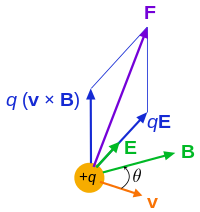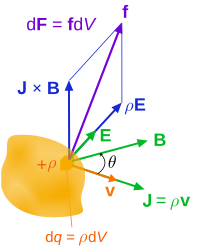The covariant formulation of classical electromagnetism refers to ways of writing the laws of classical electromagnetism (in particular, Maxwell's equations and the Lorentz force) in a form that is manifestly invariant under Lorentz transformations, in the formalism of special relativity using rectilinear inertial coordinate systems. These expressions both make it simple to prove that the laws of classical electromagnetism take the same form in any inertial coordinate system, and also provide a way to translate the fields and forces from one frame to another. However, this is not as general as Maxwell's equations in curved spacetime or non-rectilinear coordinate systems.
This article uses the classical treatment of tensors and Einstein summation convention throughout and the Minkowski metric has the form diag(+1, −1, −1, −1). Where the equations are specified as holding in a vacuum, one could instead regard them as the formulation of Maxwell's equations in terms of total charge and current.
For a more general overview of the relationships between classical electromagnetism and special relativity, including various conceptual implications of this picture, see Classical electromagnetism and special relativity.
Covariant objects
Preliminary four-vectors
Lorentz tensors of the following kinds may be used in this article to describe bodies or particles:
- four-displacement:
- Four-velocity: where γ(u) is the Lorentz factor at the 3-velocity u.
- Four-momentum: where is 3-momentum, is the total energy, and is rest mass.
- Four-gradient:
- The d'Alembertian operator is denoted ,
The signs in the following tensor analysis depend on the convention used for the metric tensor. The convention used here is (+ − − −), corresponding to the Minkowski metric tensor:
Electromagnetic tensor
The electromagnetic tensor is the combination of the electric and magnetic fields into a covariant antisymmetric tensor whose entries are B-field quantities.
Four-current
The four-current is the contravariant four-vector which combines electric charge density ρ and electric current density j:
Four-potential
The electromagnetic four-potential is a covariant four-vector containing the electric potential (also called the scalar potential) ϕ and magnetic vector potential (or vector potential) A, as follows:
The differential of the electromagnetic potential is
In the language of differential forms, which provides the generalisation to curved spacetimes, these are the components of a 1-form and a 2-form respectively. Here, is the exterior derivative and the wedge product.
Electromagnetic stress–energy tensor
The electromagnetic stress–energy tensor can be interpreted as the flux density of the momentum four-vector, and is a contravariant symmetric tensor that is the contribution of the electromagnetic fields to the overall stress–energy tensor:
where is the electric permittivity of vacuum, μ0 is the magnetic permeability of vacuum, the Poynting vector is
and the Maxwell stress tensor is given by
The electromagnetic field tensor F constructs the electromagnetic stress–energy tensor T by the equation:
Maxwell's equations in vacuum
In vacuum (or for the microscopic equations, not including macroscopic material descriptions), Maxwell's equations can be written as two tensor equations.
The two inhomogeneous Maxwell's equations, Gauss's Law and Ampère's law (with Maxwell's correction) combine into (with (+ − − −) metric):
while the homogeneous equations – Faraday's law of induction and Gauss's law for magnetism combine to form , which may be written using Levi-Civita duality as:
where Fαβ is the electromagnetic tensor, Jα is the four-current, εαβγδ is the Levi-Civita symbol, and the indices behave according to the Einstein summation convention.
Each of these tensor equations corresponds to four scalar equations, one for each value of β.
Using the antisymmetric tensor notation and comma notation for the partial derivative (see Ricci calculus), the second equation can also be written more compactly as:
In the absence of sources, Maxwell's equations reduce to:
Maxwell's equations in the Lorenz gauge
The Lorenz gauge condition is a Lorentz-invariant gauge condition. (This can be contrasted with other gauge conditions such as the Coulomb gauge, which if it holds in one inertial frame will generally not hold in any other.) It is expressed in terms of the four-potential as follows:
In the Lorenz gauge, the microscopic Maxwell's equations can be written as:
Lorentz force
Charged particle

Electromagnetic (EM) fields affect the motion of electrically charged matter: due to the Lorentz force. In this way, EM fields can be detected (with applications in particle physics, and natural occurrences such as in aurorae). In relativistic form, the Lorentz force uses the field strength tensor as follows.
Expressed in terms of coordinate time t, it is:
where pα is the four-momentum, q is the charge, and xβ is the position.
Expressed in frame-independent form, we have the four-force
where uβ is the four-velocity, and τ is the particle's proper time, which is related to coordinate time by dt = γdτ.
Charge continuum

The density of force due to electromagnetism, whose spatial part is the Lorentz force, is given by
and is related to the electromagnetic stress–energy tensor by
Conservation laws
Electric charge
The continuity equation:
Electromagnetic energy–momentum
Using the Maxwell equations, one can see that the electromagnetic stress–energy tensor (defined above) satisfies the following differential equation, relating it to the electromagnetic tensor and the current four-vector
Maxwell's equations in matter
The result is that Ampère's law,
combine into one equation:
The bound current and free current as defined above are automatically and separately conserved
Constitutive equations
Vacuum
In vacuum, the constitutive relations between the field tensor and displacement tensor are:
Antisymmetry reduces these 16 equations to just six independent equations. Because it is usual to define Fμν by
The electromagnetic stress–energy tensor in terms of the displacement is:
Linear, nondispersive matter
Lagrangian for classical electrodynamics
Vacuum
The Lagrangian density for classical electrodynamics is composed by two components: a field component and a source component:
In the interaction term, the four-current should be understood as an abbreviation of many terms expressing the electric currents of other charged fields in terms of their variables; the four-current is not itself a fundamental field.
The Lagrange equations for the electromagnetic lagrangian density can be stated as follows:
Noting
the expression inside the square bracket is
The second term is
Therefore, the electromagnetic field's equations of motion are




























![{\displaystyle F_{[\alpha \beta ,\gamma ]}=0.}](https://wikimedia.org/api/rest_v1/media/math/render/svg/d00ac4efaccdf43c6f9e303b90470fa43f807346)




















![{\displaystyle \partial _{\beta }\left[{\frac {\partial {\mathcal {L}}}{\partial (\partial _{\beta }A_{\alpha })}}\right]-{\frac {\partial {\mathcal {L}}}{\partial A_{\alpha }}}=0\,.}](https://wikimedia.org/api/rest_v1/media/math/render/svg/1a02d4079bf5859ef0b36a4e5e5b7b01d98f1dcd)




